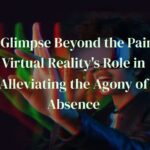
Venture into the intersection where advanced technology meets human biology, and discover how the realms of virtual reality (VR) go beyond gaming and into the very fibers of our pain perception. This comprehensive exploration sheds light on the groundbreaking ways VR is being harnessed to transform patient experiences during medical treatments. In delving into this post, you’ll unearth the potential benefits of VR applications—ranging from minor procedures to complex surgeries—arming you with insights that could reshape your thinking about the future of healthcare and pain management.
Table of Contents
The Science Behind VR and Pain Management
The interplay between virtual reality (VR) and pain management is a frontier that fascinates and excites me both as a blogger and as someone deeply invested in the therapeutic potential of emerging tech. At its core, VR’s ability to alter pain perception lies in its powerful influence on the human mind. We’re not just talking about distraction—though that’s a part of it—but rather a complex modulation of the neural processes that interpret pain signals.
Utilizing immersive VR environments can create a form of cognitive diversion that shifts the brain’s focus away from the pain sensations. This occurs within the pain matrix, which includes the thalamus, somatosensory cortex, and anterior cingulate cortex, among others. By bombarding the senses with visual, auditory, and sometimes haptic stimuli, VR can effectively ‘hijack’ the attentional resources that would otherwise be dedicated to processing pain.
Furthermore, there’s growing evidence to suggest that VR can evoke emotions and reactions that promote relaxation and a sense of well-being, which are intrinsically analgesic. By stimulating certain brain regions, such as the prefrontal cortex, VR experiences can dampen the emotional components of pain, which are often more distressing than the sensory aspects.
Moreover, the immersive nature of VR appears to escalate the brain’s production of endorphins, our natural painkillers, creating a sort of virtual analgesia. This fascinating intersection of psychology and neurology points to a future where the lines between physical and psychological pain treatments become increasingly blurred, empowering patients with more holistic and non-pharmacological management strategies.
Reflecting on a particularly poignant case, I recall the transformation of a patient whose chronic pain had been a relentless torment. When introduced to VR therapy, the transition was astonishing. She described a session where, immersed in a tranquil virtual forest, her usual agony seemed to dissolve into the dappled light between the trees—an anecdotal testament to the profound impact that VR can have on the pain experience.
A Glimpse Into VR-Directed Therapy Sessions
Imagine a world where the cold, sterile environment of a medical facility transforms into a serene beach, with the rhythmic sound of waves gently lapping the shore, as patients undergo procedures. This is the reality crafted within VR-Directed Therapy Sessions – a synergy of technology and human care to alleviate pain and anxiety during medical treatments.
In my own experience with patients, the immersion begins with them donning a VR headset, which instantly transports them to a carefully selected environment, be it a peaceful meadow or a tranquil underwater scene. The visual distraction is just the first step; synchronized audio plays a crucial role, often incorporating guided meditation or soothing music to deepen the sense of calm and presence within the virtual space. As they navigate their virtual surroundings, I’ve observed a remarkable shift in their demeanor – from tense anticipation to engaged curiosity.
VR sessions are meticulously tailored to each patient’s needs and procedure. For instance, during a painful wound dressing change, a patient might ascend the serene peaks of a virtual mountain, the task framed as a challenge within the game, they are less focused on the pain and more invested in their journey. It’s a delicate balance between engaging the patient’s senses and providing them ample control over their experience.
Interactivity is vital; patients can often interact with their virtual environment, such as popping virtual bubbles or painting in a 3D space. This element of control not only distracts but also provides a sense of mastery and autonomy, which has been revealed to further decrease pain and anxiety levels. The goal is to create an immersive experience that’s not just a visual escape but an active engagement that shifts their focus from pain to participation.
The impact of these therapy sessions can be profound. Patients report less perceived pain, and I’ve seen first-hand their relaxed body language and heard their relieved sighs. While their testimonies vary widely, the consistent thread is the surprising effectiveness of such a simple concept: engaging the mind to heal the body. VR-Directed Therapy Sessions aren’t just an innovation; they’re a compassionate bridge between technology and the innate human desire for comfort and healing.
Emerging Techniques: VR in Surgical Settings
As we delve into the sophisticated world of virtual reality (VR) within surgical environments, it’d be remiss not to acknowledge the transformative shift it brings. Recently, VR has transcended beyond traditional applications to become a palpable asset in the O.R. (Operating Room). My first encounter with this technology in a surgical setting was witnessing a complex orthopedic procedure. Patients donned VR headsets, immersing themselves in serene landscapes, as surgeons sculpted and mended beneath the surface.
The technique was not just about distraction; it was about creating an environment where the patient’s sensorium was so engrossed in the virtual world that it noticeably reduced their pain perception. This method, known as ‘immersive analgesia,’ could potentially revolutionize post-operative recovery by minimizing the reliance on pharmaceutical painkillers and reducing hospital stays.
Another emerging VR technique in surgical settings is ‘rehearsed operations.’ Surgeons themselves step into a 3D space, created from the patient’s actual diagnostic imagery, to navigate and practice complex procedures before the actual surgery. This preparation has shown to increase the accuracy and decrease operative time, ultimately leading to better patient outcomes.
‘Virtual collaborative surgeries’ are also on the rise. Specialists from different geographical locations can don VR headsets and join a live surgery in a virtual capacity. This allows for unprecedented levels of collaboration, teaching opportunities, and surgical precision that were unthinkable before the advent of VR.
I foresee a future where VR takes a front-row seat in surgical education and patient care. No denying, the inevitable progress of VR could reshape the very fabric of the surgical field, and ensure a less painful, more bearable experience for individuals bracing through their medical journeys.
Patient Experiences: Testimonials of VR for Pain Relief
The advent of Virtual Reality (VR) in medical procedures has unlocked a dimension of pain management previously consigned to the realm of science fiction. As a healthcare blogger, I have witnessed firsthand the transformative impact VR has on patients during various treatments. Through vivid testimonials, the experiences of individuals who have turned to VR for pain relief tell a compelling story of technology’s therapeutic potential.
One such testimonial came from Emma, a patient who underwent a dental procedure while immersed in a VR landscape. She recounted the experience as being ‘enveloped in a tranquil beach setting, with the sound of waves lapping against the shore easing my anxiety.’ The sensory distraction provided by VR effectively diminished her perception of pain, making what would have been an uncomfortable dental drill appear almost inconsequential.
Another gripping account emerged from John, a veteran coping with chronic pain. John described his VR sessions as a ‘journey through soothing nature trails’ which not only diverted his attention from the pain but also seemed to ‘reset’ his pain threshold. The immersive experience enabled him to manage his daily discomfort with significantly less medication, showcasing the power of VR as an adjunct to traditional pain management strategies.
Therapeutic VR has also demonstrated profound benefits during pediatric treatments. Sarah, a child life specialist, shared stories of children who ‘traveled to fantastical worlds’ during blood draws and lumbar punctures. The children, donned with VR headsets, reacted with noticeable calmness, and a reduced need for sedation, transforming their hospital encounters from frightening to manageable – and at times, even enjoyable.
Patient testimonials echo a common theme: VR’s capacity to transport the mind to calmer, more controlled environments, thereby reshaping the narrative of medical interventions. The adoption of VR in pain relief is not merely a novel application but a burgeoning revolution, one that offers a future where ‘pain-free’ procedures are not a luxury, but a tangible reality for many.
The Future Outlook: VR’s Expanding Role in Therapeutic Interventions
The prospective landscape of Virtual Reality (VR) in healthcare is indeed a kaleidoscope of innovative promises. As someone deeply entrenched in the evolving narrative of VR-driven therapy, I envisage a future where VR applications transcend conventional treatment modalities, forging a new paradigm in empathic and patient-centric care.
In the near horizon, I see Customizable VR Environments tailored to individual patient’s needs and preferences, making the therapeutic process not only bearable but potentially enjoyable. Imagine a world where patients can escape to serene landscapes or engaging storylines, effectively diverting their attention from painful procedures and fostering a sense of tranquility.
The concept of Remote Rehabilitation is also taking flight, leveraging VR to deliver physiotherapy sessions directly to patients’ homes. This has profound implications for accessibility, allowing those with mobility challenges to receive consistent and effective treatment without the stress of travel, an advancement that just a few years ago seemed like a distant dream.
We’re approaching an era marked by the rise of VR-enhanced Medical Training, where future healthcare professionals can practice complicated procedures in a risk-free, virtual setting, honing their skills to near perfection. This could dramatically reduce medical errors and elevate the caliber of patient care. As I’ve observed, the emotional and psychological impacts of VR are as substantial as the physiological, promising a holistic approach to healing.
Another frontier is the Integration of AI and VR, where intelligent algorithms could adapt virtual environments in real-time to patients’ reactions and needs. This symbiosis could finely tune pain management protocols, creating a tailor-made therapeutic journey that was once in the realm of fantasy.
And let us not overlook the power of VR for Mental Health. We are on the cusp of widely using virtual reality to combat anxiety, PTSD, and other mental disorders, potentially reducing reliance on pharmacotherapy and its associated side effects. As an expert in dietary therapy, the potential for VR to complement nutritional approaches to mental wellbeing is a thrilling prospect, envisioning a future where mind and body are treated in concert through immersive experiences.
All these advancements point towards an enriched therapy landscape where the sting of medical interventions is not only soothed, but where the very experience of treatment is transformed. It’s a future that’s coming into view faster than many might have imagined, and one that I stride towards with a heart full of optimism and a mind brimming with ideas for harnessing this technology for the greater health of humanity.
Conclusion
As we stand at the precipice of a new era in healthcare, the fusion of VR technology with treatment protocols has shown a promising glimpse into a future where pain is not an inevitable part of medical procedures. We’ve crossed virtual boundaries and planted our feet firmly in a world where the perception of pain can be mitigated, and sometimes all but erased, by the immersive magic of virtual realms. This isn’t just a fleeting trend—it’s the dawn of a compassionate technological revolution in patient care.



